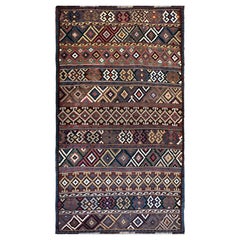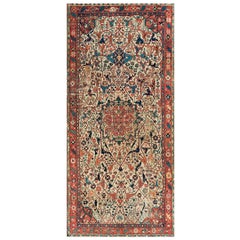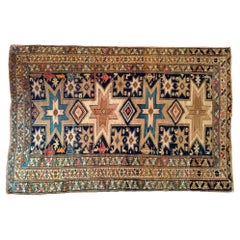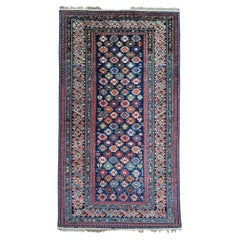1830s Caucasian Rugs
to
Width
to
Length
to
2
12
1,848
2,216
231
1,202
704
199
278
103
223
204
108
56
75
40
21
23
2
2
1
1
1
2
2
2
2
1
1
1
1
Period: 1830s
Kilim Caucasus 19th 270 X 155 - No. 847
Located in Paris, FR
Kilim in the Caucasus, representing geometric shapes of tribal style.
High quality, beautiful graphics and remarkable finesse.
Perfect state of preservation.
Measures: 106.29 in. x 61.02 in.
kilim de Caucase, représentant des formes géométriques du style tribal.
De grande...
Category
Turkestan Kilim Antique 1830s Caucasian Rugs
Materials
Silk, Wool
19th Century Caucasian Karabagh Gallery Carpet ( 7' x 15'9" - 213 x 480 )
Located in New York, NY
19th Century Caucasian Karabagh Gallery Carpet Dated 1834
7' x 15'9" - 213 x 480
Category
Caucasian Antique 1830s Caucasian Rugs
Materials
Wool
Related Items
1059, Caucasian Shirvan Carpet 19th Century
Located in Paris, FR
Nice 19th century shirwan rug with a beautiful pattern and pretty natural colors, entirely hand-knotted with wool pile on a wool base.
Category
Azerbaijani Tribal Antique 1830s Caucasian Rugs
Materials
Wool
Middle of 19th Century East Caucasus Kuba region Chi-Chi Rug
Located in Sultanahmet, 34
Middle of 19th Century East Caucasus Kuba region Chi-Chi Rug
Category
Caucasian Antique 1830s Caucasian Rugs
Materials
Wool
Antique Caucasus Soumak Kilim Sumac Rug, Caucasian Sumak Natural Carpet
Located in Tokyo, JP
This is an Antique Soumak ( Sumak, Sumac ) Kilim from the Caucasus region with a rare and beautiful color composition.
Of the four countries that make up the Caucasus, Azerbaijan produces the most kilims, and the land has a long history of weaving. The nomadic tribes wove kilims and carpets as well as a wide range of storage bags and sacks, such as saffrash, khurgin and chula, and donkey and horse trappings. Smaller bags for salt, utensils, and other items are also common. Not only are the Azerbaijani weavers prolific, but they also employ many techniques at the loom. These include slitweave- known locally by the word Kilim, warp-faced patterning (jajim), supplementary weft (zili), weft wrapping (popularly known as soumak), and extra weft wrapping (verneh). Furthermore, flatweaves are defined by regional names such as palas and shadda, so it is possible to ascribe a variety of weaving names to particular provenances as follows: soumaks are made in Kuba, palas, and kilims in Hajikabul, zili in Khizy, verneh and zili in Kazakh, shadda, verneh and zili in Barda, jajim in Agjabedi, and palas and kilims in Jabrail.
Soumak weave is a technique in which weft threads are added to a plain weave fabric, and one or two warp threads are wound from the front to the back. The resulting Kilim is denser and firmer, giving it a unique feel and look. This technique is commonly used in the Caucasus region.
Soumak kilims have a very beautiful contrast between orange that shines like the sun, deep purple-tinged indigo, and astringent dark red. You can also see the unevenly dyed abrage in this Soumak, which is like a magic carpet with an oriental atmosphere. Features of the Caucasian Kilim, such as the unique cosmic geometric floral pattern, are also found in this Soumak which has a bright look, but it also has a faded and textured feel, so it can be used in a good old atmosphere.
The woven fabric is particularly solid, so it is recommended for use in a solid living room or under a dining table without moving or twisting. A nice Kilim under a long wooden dining table.
Category
Caucasian Kilim Antique 1830s Caucasian Rugs
Materials
Wool, Natural Fiber
19th Century Antique Caucasus Kazak Gallery Carpet With Dual Geometric Medallion
Located in Atlanta, GA
Antique Caucasus Kazak Carpet with Dual Geometric Medallions.
This stunning 19th century Kazak rug from the Caucasus region displays magnificent, dual, geometric medallions and an al...
Category
Armenian Kazak Antique 1830s Caucasian Rugs
Materials
Wool
$9,300 Sale Price
40% Off
W 163 in L 80 in
19th Century Antique Karabagh Rug, Caucasus Kazak Karabakh Carpet, Natural Dyed
Located in Tokyo, JP
This is an antique Kazak rug from the late 19th century, Karabakh region, Caucasus area.
Experience the rich heritage and artistry of our antique Kazak Karabagh Caucasian rug, a ma...
Category
Turkish Oushak Antique 1830s Caucasian Rugs
Materials
Wool, Natural Fiber, Organic Material
$8,650
W 48.43 in L 82.68 in
Caucasus Kuba Fine Kilim Vintage Old Rug, Caucasian Natural Carpet
Located in Tokyo, JP
This is a Caucasian Old Kilim from the Kuba region with a red background and beautiful color composition.
Kilim of Kuba, a city in Azerbaijan. It is located by the Caspian Sea, ne...
Category
Caucasian Kilim 1830s Caucasian Rugs
Materials
Wool, Natural Fiber
$1,560 Sale Price
20% Off
W 74.81 in L 127.96 in
19th Century Antique Caucasian Karabagh Rug
Located in Barueri, SP, BR
Antique Karabagh with Geometric Elegance – A Rich Heritage in Every Thread
Step into a world of timeless beauty with this antique geometric rug...
Category
Caucasian Antique 1830s Caucasian Rugs
Materials
Wool
Antique Caucasus Soumak Kilim Sumac Rug, Caucasian Natural Carpet
Located in Tokyo, JP
This is a large Antique Soumak ( Sumak, Sumac ) Kilim from the Caucasus region with a rare and beautiful color composition.
Of the four countries that make up the Caucasus, Azerbaijan produces the most kilims, and the land has a long history of weaving. The nomadic tribes wove kilims and carpets as well as a wide range of storage bags and sacks, such as saffrash, khurgin and chula, and donkey and horse trappings. Smaller bags for salt, utensils, and other items are also common. Not only are the Azerbaijani weavers prolific, but they also employ many techniques at the loom. These include slitweave- known locally by the word kilim, warp-faced patterning (jajim), supplementary weft (zili), weft wrapping (popularly known as soumak), and extra weft wrapping (verneh). Furthermore, flatweaves are defined by regional names such as palas and shadda, so it is possible to ascribe a variety of weaving names to particular provenances as follows: soumaks are made in Kuba, palas, and kilims in Hajikabul, zili in Khizy, verneh and zili in Kazakh, shadda, verneh and zili in Barda, jajim in Agjabedi, and palas and kilims in Jabrail.
Soumak weave is a technique in which new weft threads are added to a plain weave fabric, and one or two warp threads are wound from the front to the back. The resulting kilim is denser and firmer, giving it a unique feel and look. This technique is commonly used in the Caucasus region.
Soumak Kilims have a very beautiful contrast between orange that shines like the sun, deep purple-tinged indigo, and astringent dark red. You can also see the unevenly dyed abrage in this sumac, which is like a magic carpet with an oriental atmosphere.
Features of the Caucasian kilim, such as the unique cosmic geometric floral pattern, are also found in this Soumak. It has a bright look, but it also has a faded and textured feel, so it can be used in a good old atmosphere. The woven fabric is particularly solid, so it is recommended for use in a solid living room or under a dining table without moving or twisting. A nice kilim under a long wooden dining table.
Category
Caucasian Kilim 1830s Caucasian Rugs
Materials
Wool, Natural Fiber
Antique Karachov Kazak Rug Karachoph Southwest Caucasus Carpet Late-19th Century
Located in Tokyo, JP
This is an antique Karachov Kazak Rug from the Karachov / Karachoph region, Southwest Caucasus.
The town of Karachov (sometimes rendered Karatchoph o...
Category
Caucasian Oushak Antique 1830s Caucasian Rugs
Materials
Wool, Natural Fiber, Organic Material
$12,000
W 66.93 in L 84.26 in
19th Century Antique Caucasian Lenkoran Karabagh Rug
Located in Barueri, SP, BR
Exquisite Caucasian Lenkoran Rug – A Timeless Masterpiece of Art and Tradition
Imagine bringing centuries of artistry and tradition into your home with this Antique Caucasian Lenkor...
Category
Caucasian Antique 1830s Caucasian Rugs
Materials
Wool
Old Caucasus Soumak Sumac Kilim Rug, Caucasian Natural Sumak Carpet
Located in Tokyo, JP
This is an old Soumak ( Sumak, Sumac ) Kilim from the Caucasus region with a rare and beautiful color composition.
Of the four countries that make up the Caucasus, Azerbaijan produces the most kilims, and the land has a long history of weaving. The nomadic tribes wove kilims and carpets as well as a wide range of storage bags and sacks, such as saffrash, khurgin and chula, and donkey and horse trappings. Smaller bags for salt, utensils, and other items are also common. Not only are the Azerbaijani weavers prolific, but they also employ many techniques at the loom. These include slitweave- known locally by the word kilim, warp-faced patterning (jajim), supplementary weft (zili), weft wrapping (popularly known as soumak), and extra weft wrapping (verneh). Furthermore, flatweaves are defined by regional names such as palas and shadda, so it is possible to ascribe a variety of weaving names to particular provenances as follows: soumaks are made in Kuba, palas, and kilims in Hajikabul, zili in Khizy, verneh and zili in Kazakh, shadda, verneh and zili in Barda, jajim in Agjabedi, and palas and kilims in Jabrail.
Soumak weave is a technique in which weft threads are added to a plain weave fabric, and one or two warp threads are wound from the front to the back. The resulting kilim is denser and firmer, giving it a unique feel and look. This technique is commonly used in the Caucasus region.
Soumak has a very beautiful contrast between orange that shines like the sun, deep purple-tinged indigo, and astringent dark red. You can also see the unevenly dyed abrage in this Soumak, which is like a magic carpet with an oriental atmosphere. Features of the Caucasian kilim, such as the unique cosmic geometric floral pattern, are also found in this Soumak which has a bright look, but it also has a faded and textured feel, so it can be used in a good old atmosphere.
The woven fabric is particularly solid, so it is recommended for use in a solid living room or under a dining table without moving or twisting. A nice kilim under a long wooden dining table.
Category
Caucasian Kilim 1830s Caucasian Rugs
Materials
Wool, Natural Fiber
Antique Sewan Kazak Rug Sevan Caucasian Carpet Late-19th Century Caucasus
Located in Tokyo, JP
This is a rare antique Sewan Kazak Rug from the Sewan / Sevan region in the southwest Caucasia.
This is another handsome example of the “Sewan” Ka...
Category
Caucasian Oushak Antique 1830s Caucasian Rugs
Materials
Wool, Natural Fiber, Organic Material
$12,500
W 60.24 in L 95.67 in
Recently Viewed
View AllMore Ways To Browse
Animal Garden Seat
Antique Battle Axe
Antique Battle Axes
Antique Birdseye Maple Chest Of Drawers
Antique Biscuit Jar
Antique Chinese Embroidered Panels
Antique Cigar Holder
Antique Cobalt Blue Glass Bottles
Antique Cooling Board
Antique Derby Porcelain Figures
Antique Door Knobs With Plates
Antique French Vaisselier
Antique Fruit Coolers
Antique Glass Cloche
Antique Glass Finger Bowls
Antique Gothic Trunk
Antique Gravy Bowls
Antique Ice Cabinet



